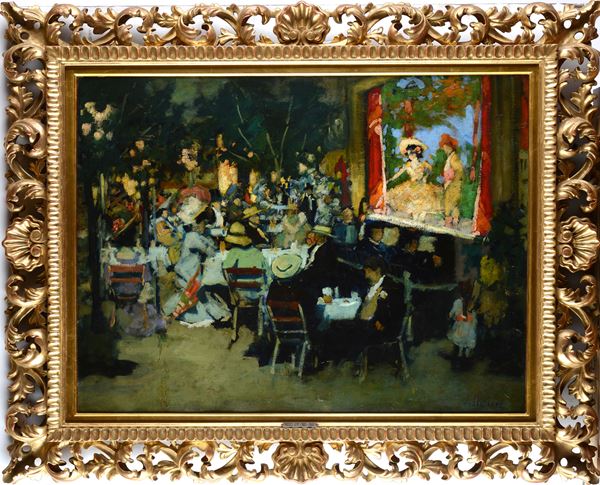cm. 67x81
Signature and date lower right.
Bibliography: F. Bosetti, Moses Levy painter, after 1945, pp. 41 ff, inMoses Levy. Sweetness will return to the sea, Lucca, 2019 (catalogue of the Viareggio exhibition 3 February - 15 September, GAMC.).
Authentication by Loly Levy on photo. Certificate of authenticity by Enrico Dei.
The remarkable painting presented here – Variety Show, 1918 – belongs to the limited group of works, whose history exhibition has certain very remote references: in fact, its exhibition at the Florentina Ars – Painters of today is attested, between October and November 1918, where it appears at catalog number 213.The canvas constitutes one of the clearest examples of that transition period, for Levy, marked by the progressive – and rapid, basically – transition from figurative modules typical of late impressionism and vague inspiration to stain, towards a completely peculiar language, which will permanently characterize his art at least until the middle of next decade. Time, this (1918-1925, with precursors and contemporary experiments in cutting and stylistic features at all several) albeit brief, in which the themes best known to the general public progressively asserted themselves: in fact, that wasthe season of bright and captivating seascapes, of the undisputed dominion of light, of the celebration of a absolute vitality and an apparent joie de vivre which, in the prevalence of taste, explain the easy and unchallenged
< p>success of those subjects even today.
The Spectacle, in reality, is a highly significant work in many other ways, since it allows us to reveal once more the complexity of the Artist, defining the themes, the technique and his notable historical importance, the < span style="background-color: hsl(var(--bs-white)); color: var(--bs-card-color); font-size: var(--bs-body-font-size); text-align: var(--bs-body-text-align);">measure of that overall evolutionary process mentioned above.
If we were already relying on the formal data alone, there is no doubt that countless references resonate in the work, which the attentive observer cannot fail to grasp: the setting and the general composition, vaguely Manetian; the stage on the right, which takes us back to the scheme of the painting within the painting, with that bright break and those singular proportions; self-citation (which will be a recurring theme in L.'s last painting), made up of different e characteristic human figures, among which the little girl in the foreground is very evident, referable to the very famous and coeval postcard kiosk, formerly in the Baer collection (C.L: RAGGHIANTI, Moses Levy, Florence, 1975, pl. span>dynamics of humanity in the background, barely sketched and immersed in whitish flashes, which contribute to giving both depth and movement to the composition, denouncing the evidence of a contact – by nowovercome and metabolized - with the dynamic concepts of Futurism. How much, then, are these last signals destined to resulting in the shorthand language of the 1930s, does not require underlining for the present context.With reference, however, to the purely historical placement of the painting in Levy's work, we observe that the subject is part of that peculiar trend, explored several times in the years 1918-1921, centered on nightlife of Viareggio at the beginning of the twentieth century: the Kursaal of Orsino Bongi, inaugurated in 1912, was the centre ideal, and we outlined its physiognomy on several occasions, in similarly and widely known paintings.Precisely in this context (see for example C.L. Ragghianti, op. cit., Giardino del Kursaal, pl. XXX; as well as Kursaal Gardens, plate XXXV) fully includes the variety show, which constitutes a work in all respects < span style="background-color: hsl(var(--bs-white)); color: var(--bs-card-color); font-size: var(--bs-body-font-size); text-align: var(--bs-body-text-align);">exemplary, and therefore fundamental, for the purposes of the most complete and correct understanding of the itinerarypictorial by Levy, at the dawn of the third decade of the twentieth century and before the flight towards the synthesis of the Second Afterwar, which we have discussed more fully elsewhere.(The painting is present in the writer's personal archive, under the unique identification number VRG 18 271 of 26 October 2010).
Francesco Bosetti






